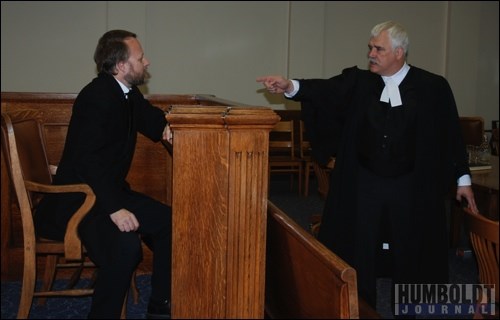Humboldt's historic courthouse was once again the stage for one of the most important trials in the history of Canada last week.
On June 2, the "Trial of Louis Riel," a recreation of one of Canada's most famous trials, produced by RielCo Productions was held at the court house in Humboldt in front of a capacity crowd.
This was the second showing of the play within a year's time. It was performed last year in mid-June, as part of commemoration ceremonies for the Original Humboldt site. The 2011 performance also concluded a day of commemoration, as a ceremony was held the afternoon of June 2 at the Original Humboldt site - something that could not be done in 2010, due to the wetness of the field.
"Many colourful characters from our history made history here," said Dennis Korte, a member of the Original Humboldt committee, who introduced the play.
Prime Minister John Diefenbaker, for example, made an appearance at the Humboldt courthouse, which was built between 1914-16 and was designated a Municipal Heritage site in 1984.
Of course, Humboldt has close ties to Louis Riel, as soldiers were stationed at the Original Humboldt site in 1885 during the Rebellion that bears his name, which is why the play, written using actual trial transcripts, was chosen as a way to cap off the commemoration ceremonies.
Peter Champagne, the producer of the "Trial of Louis Riel," and an actor in the play, had nothing but praise for the setting in Humboldt.
Last year, he said, Humboldt was the first stop on a rare tour that took the play across Saskatchewan, into Manitoba and even to Ottawa.
"Of all the special places we went to, the show, personally, I thought was the greatest I've been in, was the show in here last year," he said, gesturing to the courtroom around him.
"It's such a personal show here," he said. "And I believe... this is the only place... that resembles where he was tried in 1885... There's no stage, he's right, smack in the middle (of the room)," he stated, gesturing to the prisoner's box.
It was definitely an authentic setting for the trial, with the original woodwork and setup of the room, with the prisoner's box directly across from the judge, behind the tables where the lawyers sit.
Just a handful of things had to be changed to transform the courtroom from one used for modern day court appearances to the setting for the trial of Riel. The pictures of Queen Elizabeth II and Prime Minister Stephen Harper were replaced with those of Queen Victoria and Prime Minister John A. McDonald, the Red Maple Leaf flag was replaced with the Union Jack, and recording equipment that usually decorates the tables was removed.
"I thought it was such a remarkable show (in Humboldt in 2010)," Champagne continued. "Every little thing... every little nuance... every one got.... For me, it was magic."
The 2011 show was no less magical.
Between the robes of the Crown Prosecutors and their references to their "learned friends" when referring to one another, it could have been an actual, modern trial, save for the positioning of the prisoner, the fact that he wore a ball and chain, and the language used by the witnesses and the lawyers.
Charged with high treason, the most "pernicious crime" a man can be accused of, the judge stated, Riel reacted convincingly to statements by witnesses he believed were lies, and kept the audience guessing about the evidence against him. He also gave a moving and eloquent speech, in his own defence.
Between Riel's own words and action, and those of the rest of the characters, the audience was forced to consider many of the same questions historians have been asking for the past 126 years.
Was Riel a martyr or a traitor? Was he incredibly intelligent and shrewd or absolutely crazy?
Was he a prophet or a lunatic? A great leader of a downtrodden people or a megalomaniac?
The audience was left to draw their own conclusions as the well-crafted play drew to a close.
In the end, as always, Riel was found guilty of treason and sentenced to be "hanged by your neck until you are dead," as the judge put it.
The six jurors who handed Riel his fate, were, in this case, all local people from Humboldt: Colin Roy, Roman Wassermann, Tony Muggli, Nick Kaminsky, Garry Jenkins and Leon Fleischhacker.
The jurors posed for photos with the professional actors in the play after the close, standing side-by-side with Wilfred Gayleard, who played Riel, just moments after declaring him guilty of high treason.




